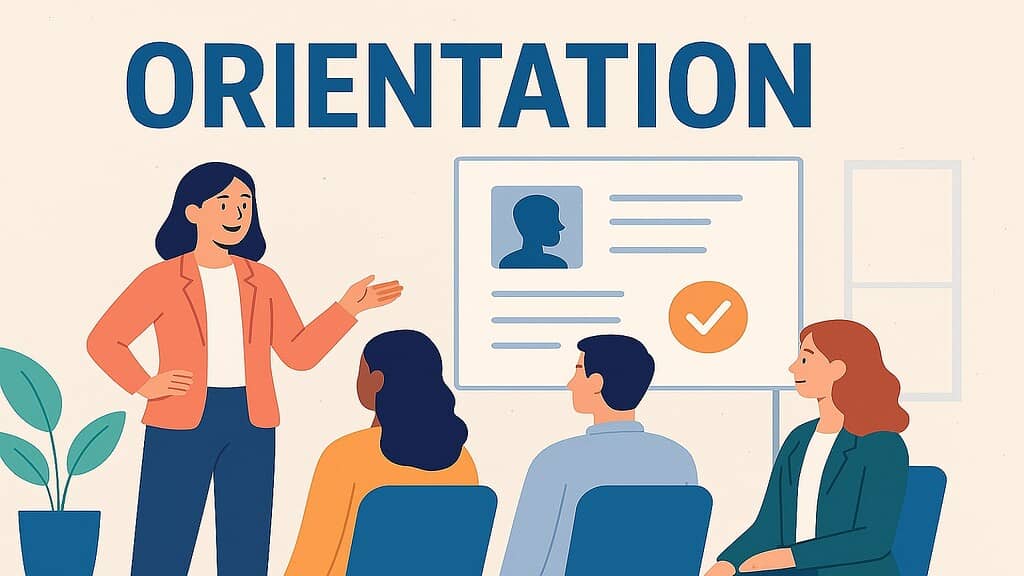Table of Contents
Introduction: Why Orientation is the First Step to Retention
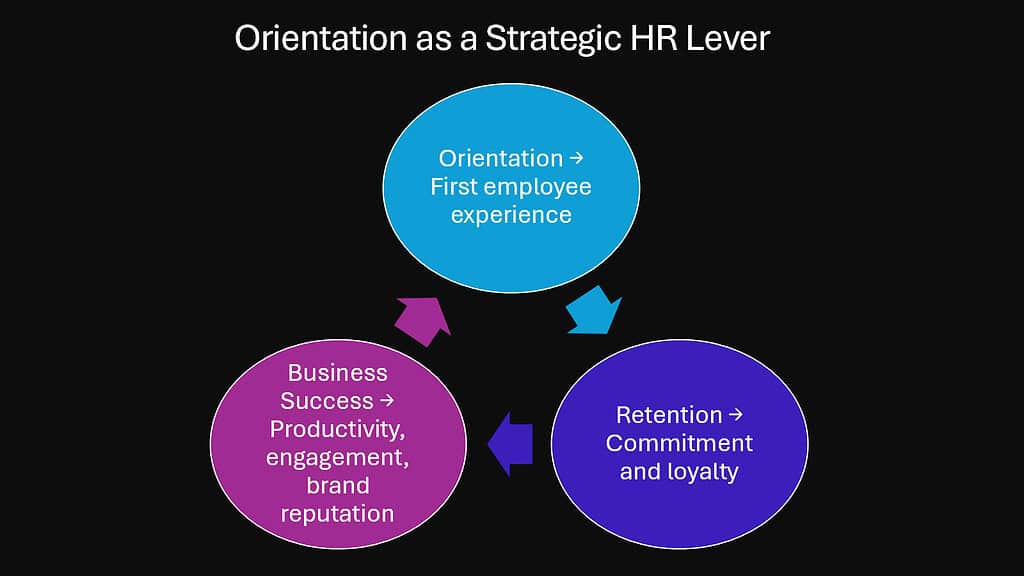
The first day at work often determines whether an employee stays for years or leaves within months. While many organizations treat orientation as a mere administrative formality, forward-thinking companies recognize it as a strategic weapon in the battle for talent retention. The cost of employee turnover continues to climb, with organizations spending substantial resources on recruitment, training, and lost productivity when workers exit prematurely.
Orientation represents far more than welcome presentations and handbook distribution. It serves as the critical foundation upon which employee loyalty, engagement, and long-term commitment are built. Research from the Society for Human Resource Management indicates that effective orientation programs can improve employee retention by up to forty percent in the first year. This striking statistic underscores the enormous strategic implications that orientation holds for business success.
The modern workplace demands that orientation evolve from a passive information-sharing session into an active retention strategy. Companies that master this transformation create competitive advantages through reduced turnover costs, enhanced productivity, and stronger organizational culture. The process establishes psychological contracts between employers and employees while setting clear expectations for mutual success.
Smart organizations understand that orientation impacts virtually every aspect of human resources. When executed strategically, it becomes the cornerstone that supports recruitment efforts, training initiatives, leadership development, and employee engagement programs. The ripple effects extend throughout the organization, influencing everything from performance management to succession planning.
This article explores six powerful ways that orientation functions as a perfect retention strategy. These approaches transform the traditional first-day experience into a comprehensive system that builds psychological safety, aligns expectations, addresses fundamental human needs, creates social connections, signals growth opportunities, and establishes the foundation for long-term employee success. Each strategy draws upon established business theories and frameworks to provide actionable insights for HR professionals and organizational leaders.
The following analysis demonstrates how strategic orientation programming moves beyond welcome ceremonies to become a sophisticated retention engine that drives organizational success and employee satisfaction.
Table 1: How Orientation Impacts Key HR Functions
| HR Function | Orientation Impact | Strategic Value |
|---|---|---|
| Recruitment | Sets realistic job previews and attracts quality candidates | Reduces early turnover and hiring costs |
| Training | Establishes learning foundation and identifies skill gaps | Accelerates competency development |
| Leadership | Introduces management philosophy and leadership expectations | Builds early manager-employee relationships |
| Employee Relations | Creates positive first impressions and open communication channels | Prevents misunderstandings and conflicts |
| Employee Engagement | Generates initial enthusiasm and connection to company mission | Increases long-term commitment levels |
| Exit Management | Provides benchmark for comparing departure reasons | Identifies improvement opportunities |
| Organizational Development | Communicates culture, values, and behavioral expectations | Strengthens cultural alignment |
| Change Management | Prepares new hires for ongoing organizational evolution | Builds adaptability and resilience |
| Onboarding | Forms comprehensive integration process foundation | Ensures smooth transition to productivity |
| Compensation Benefits | Explains total rewards package and value proposition | Enhances perceived employment value |
| Offboarding | Establishes positive relationship precedent for future interactions | Maintains alumni network relationships |
1. Orientation and Psychological Safety: Building Early Trust
Amy Edmondson’s groundbreaking research on psychological safety reveals why some teams thrive while others struggle with innovation and performance. Her framework demonstrates that employees need to feel safe to speak up, make mistakes, and contribute authentically without fear of negative consequences. Orientation programs that prioritize psychological safety create environments where new employees can engage fully from their first day, dramatically improving retention outcomes.
Traditional orientation approaches often overwhelm new hires with policies, procedures, and warnings about what not to do. This approach inadvertently creates anxiety and defensiveness rather than engagement and enthusiasm. Psychologically safe orientation experiences focus on welcoming authenticity, encouraging questions, and establishing trust between new employees and their colleagues. When people feel safe to be themselves, they invest more deeply in their work relationships and organizational success.
Companies that build psychological safety into orientation see remarkable results in employee confidence and early performance. New hires become willing to admit knowledge gaps, seek help when needed, and contribute ideas during their initial weeks. This openness accelerates learning curves and integration processes while reducing the stress and uncertainty that drive early turnover decisions.
The creation of psychological safety during orientation requires intentional design and consistent execution. Leaders must model vulnerability by sharing their own learning experiences and mistakes. Team members need training on how to welcome new colleagues without judgment or criticism. The physical and emotional environment must signal acceptance and support rather than scrutiny and evaluation.
Research consistently shows that employees who experience psychological safety during their first ninety days demonstrate higher levels of engagement, creativity, and retention. They form stronger relationships with supervisors and colleagues, leading to increased job satisfaction and organizational commitment. The investment in creating psychologically safe orientation experiences pays dividends through reduced recruitment costs and improved team performance.
Organizations across industries are discovering that psychological safety serves as a powerful retention tool when implemented from day one. Technology companies report improved innovation rates when new engineers feel comfortable proposing novel solutions. Healthcare organizations see better patient outcomes when new staff members quickly integrate into collaborative care teams. The universal applicability of this approach makes it valuable across diverse business contexts.
Table 2: Psychological Safety Elements in Orientation
| Safety Element | Traditional Approach | Psychologically Safe Approach |
|---|---|---|
| Mistake Handling | Emphasis on avoiding errors | Framing mistakes as learning opportunities |
| Question Asking | Limited to designated Q&A periods | Encouraged throughout all sessions |
| Idea Sharing | Discouraged during initial period | Welcomed and acknowledged positively |
| Feedback Culture | Top-down correction focus | Bi-directional dialogue emphasis |
| Learning Pace | Standardized timeline expectations | Individualized based on comfort levels |
| Support Systems | Formal reporting structures only | Multiple informal and formal options |
| Cultural Integration | Passive observation expected | Active participation encouraged |
2. Orientation and Job Satisfaction: Aligning Expectations Early
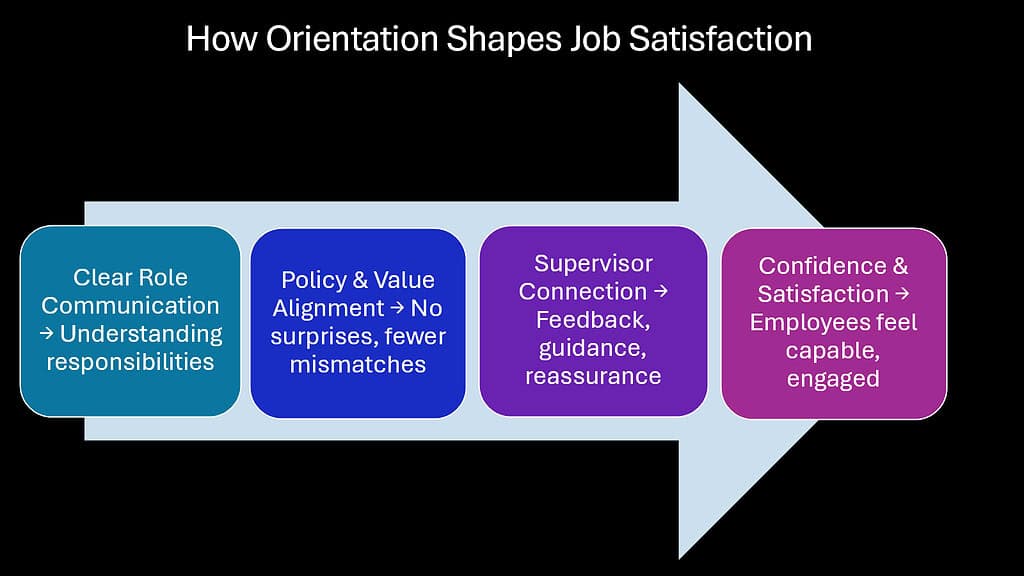
Job satisfaction emerges from the delicate balance between employee expectations and organizational reality. When orientation programs fail to align these elements properly, disappointment and disengagement follow quickly. Strategic orientation addresses this challenge by creating transparent, honest, and comprehensive pictures of what employees can expect while clarifying what the organization needs in return. This mutual understanding forms the foundation for sustained job satisfaction and retention.
Misaligned expectations represent one of the primary drivers of early employee turnover. Workers who discover that their actual job responsibilities differ significantly from what they understood during recruitment feel deceived and undervalued. Similarly, employees who lack clear understanding of performance standards, advancement opportunities, or organizational culture struggle to find their place within the company structure. Effective orientation prevents these disconnects by establishing realistic and detailed expectations from the beginning.
The expectation alignment process requires honest communication about both positive and challenging aspects of the role and organization. New employees need to understand not just what makes the company great, but also what difficulties they might encounter and how the organization supports workers through challenges. This balanced perspective builds credibility and trust while preparing people for realistic experiences rather than idealized visions.
Companies that excel at expectation alignment during orientation create detailed job previews that go beyond basic task descriptions. They explain decision-making processes, communication styles, performance measurement systems, and growth trajectories. New hires learn about typical career paths, skill development opportunities, and the time frames associated with various advancement possibilities. This comprehensive approach helps people make informed decisions about their commitment levels.
Research demonstrates that employees with well-aligned expectations show higher levels of job satisfaction throughout their tenure. They experience less stress during the adjustment period, demonstrate better early performance, and express greater confidence in their career choices. The clarity provided during orientation continues to benefit both employees and organizations long after the initial period ends.
Industries with complex or demanding work environments particularly benefit from thorough expectation alignment. Healthcare organizations that clearly communicate the emotional demands of patient care see improved nurse retention. Financial services companies that explain regulatory requirements and client service expectations experience better advisor longevity. The investment in detailed orientation pays dividends across diverse professional contexts.
Table 3: Expectation Alignment Components
| Component | Details Covered | Retention Impact |
|---|---|---|
| Role Clarity | Specific duties, responsibilities, and boundaries | Reduces confusion and role conflict |
| Performance Standards | Measurement criteria, evaluation timing, and feedback processes | Increases confidence and goal achievement |
| Career Pathways | Advancement possibilities, required skills, and typical timelines | Enhances long-term engagement and planning |
| Organizational Culture | Values, communication styles, and behavioral norms | Improves cultural fit and belongingness |
| Support Resources | Available assistance, mentoring programs, and development opportunities | Builds confidence and competence |
| Compensation Philosophy | Pay structures, benefit details, and total rewards approach | Increases perceived fairness and value |
| Work Environment | Physical conditions, technology tools, and workplace policies | Reduces adjustment stress and surprises |
3. Orientation Through Herzberg’s Motivation-Hygiene Theory
Frederick Herzberg’s revolutionary two-factor theory distinguishes between hygiene factors that prevent dissatisfaction and motivators that create satisfaction. This framework provides powerful insights for designing orientation programs that both eliminate sources of early frustration and generate genuine enthusiasm for the work ahead. Strategic orientation addresses hygiene factors immediately while introducing motivators that inspire long-term commitment and engagement.
Hygiene factors include basic workplace conditions, policies, supervision quality, and interpersonal relationships that employees expect as minimum standards. When these elements are missing or inadequate, dissatisfaction results regardless of how exciting the work might be. Orientation programs must address these foundational needs quickly and comprehensively to prevent early negative impressions that drive turnover decisions.
Common hygiene factor failures during orientation include unclear policies, inadequate workspace setup, poor supervisor introduction, and confusing administrative processes. New employees who struggle with basic logistical issues become frustrated and question their decision to join the organization. By contrast, smooth handling of these elements creates positive first impressions and demonstrates organizational competence and care for employee welfare.
Motivators represent the factors that generate genuine job satisfaction and engagement. These encompass chances for accomplishment, acknowledgment, significant work, accountability, progression, and individual development. While hygiene factors must be addressed first, strategic orientation programs quickly move beyond basic requirements to showcase the motivating aspects of the role and organization.
The most effective orientation approaches create early wins that demonstrate both hygiene factor adequacy and motivator potential. New employees receive the necessary tools and information efficiently while also experiencing recognition, learning opportunities, and glimpses of future growth possibilities. This combination builds confidence while generating excitement about the journey ahead.
International research supports the universal applicability of Herzberg’s framework across cultures and industries. Japanese companies that focus on both job security (hygiene) and continuous improvement opportunities (motivator) report exceptional retention rates. European organizations that balance work-life policies (hygiene) with meaningful project assignments (motivator) see similar success patterns. The framework’s versatility makes it valuable for global organizations with diverse workforces.
Table 4: Herzberg’s Theory Applied to Orientation
| Factor Type | Orientation Elements | Expected Outcomes |
|---|---|---|
| Hygiene Factors | Clear policies, adequate workspace, responsive supervision | Prevents early dissatisfaction and turnover |
| Hygiene Factors | Fair compensation explanation, reasonable work conditions | Establishes baseline satisfaction levels |
| Hygiene Factors | Positive colleague introductions, supportive team dynamics | Builds comfortable social environment |
| Motivators | Achievement opportunities, recognition for early contributions | Generates enthusiasm and engagement |
| Motivators | Meaningful work connection, purpose alignment discussions | Increases intrinsic motivation levels |
| Motivators | Growth pathway explanations, skill development plans | Builds long-term commitment and planning |
| Motivators | Responsibility assignments, autonomy demonstrations | Enhances job satisfaction and ownership |
4. Orientation and Social Belonging: Creating Lasting Connections
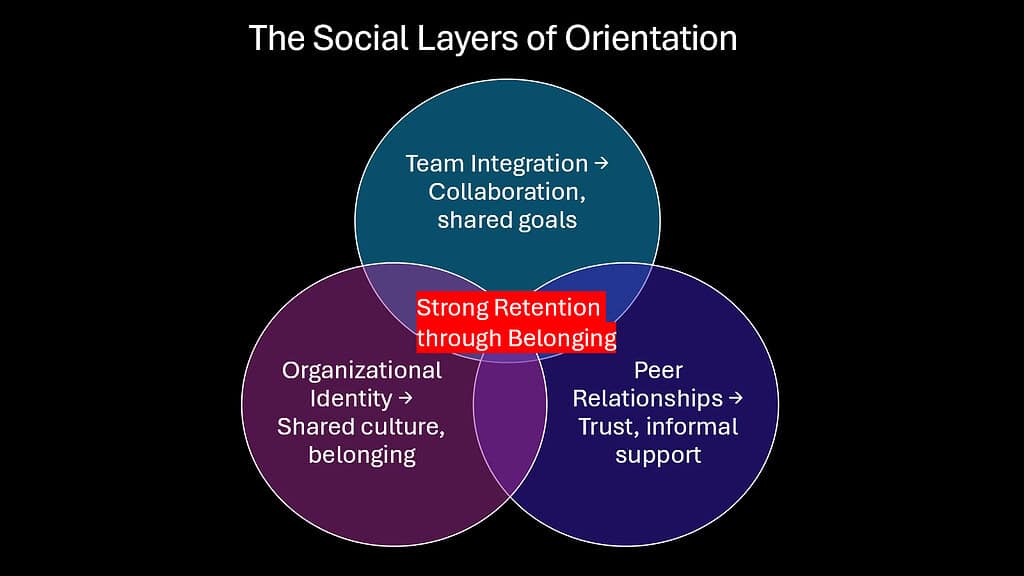
Human beings are fundamentally social creatures who thrive when they feel connected to others and accepted as valued group members. The need for belonging ranks among our most powerful motivators, influencing everything from performance levels to retention decisions. Orientation programs that prioritize social connection and belonging create emotional bonds that transcend job satisfaction and compensation considerations, resulting in deeper organizational commitment and longer tenure.
Social belonging develops through meaningful interactions, shared experiences, and gradual integration into existing team dynamics. Traditional orientation approaches often neglect this crucial element, focusing instead on information transfer and administrative tasks. While these elements remain important, they fail to address the fundamental human need for acceptance and connection that drives long-term engagement decisions.
Effective social integration during orientation requires intentional design and sustained effort from multiple organizational levels. New employees need opportunities to interact with colleagues beyond formal introductions, participate in shared activities that build relationships, and gradually find their place within the social fabric of the organization. These connections provide emotional support during the adjustment period while creating networks that enhance job satisfaction and performance.
The impact of social belonging extends far beyond individual comfort levels. Employees with strong workplace relationships demonstrate higher levels of creativity, collaboration, and resilience during challenging periods. They communicate more openly, share knowledge more freely, and contribute more actively to team success. The investment in building these connections during orientation pays dividends throughout the employment relationship.
Cultural considerations play important roles in designing socially focused orientation programs. Some cultures emphasize individual achievement while others prioritize group harmony. American organizations might focus on networking and personal connections, while East Asian companies emphasize collective identity and group membership. European approaches often balance individual recognition with team integration, reflecting cultural values around both personal success and social responsibility.
Research from multiple continents confirms that employees with strong workplace friendships show significantly higher retention rates and job satisfaction scores. Indian technology companies that emphasize team bonding during orientation report lower attrition in competitive talent markets. German manufacturing firms that integrate new workers into existing social structures see improved productivity and quality outcomes. The universal nature of belonging needs makes this approach valuable across diverse global contexts.
Table 5: Social Belonging Strategies in Orientation
| Strategy | Implementation Approach | Belonging Outcome |
|---|---|---|
| Buddy Systems | Pairing new hires with experienced colleagues | Provides immediate social support and guidance |
| Team Activities | Group projects, shared meals, collaborative exercises | Builds relationships through common experiences |
| Informal Interactions | Coffee breaks, walking meetings, casual conversations | Creates natural connection opportunities |
| Cultural Integration | Values discussions, tradition explanations, ritual participation | Develops shared identity and group membership |
| Network Introduction | Cross-departmental meetings, mentor connections, leadership interactions | Expands relationship base and support systems |
| Social Events | Welcome gatherings, team celebrations, company traditions | Generates positive shared memories and bonds |
| Communication Channels | Team messaging, social platforms, regular check-ins | Maintains ongoing connection and belonging |
5. Orientation Through Maslow’s Hierarchy of Needs
Abraham Maslow’s hierarchy of needs provides a comprehensive framework for understanding human motivation and designing orientation programs that address fundamental psychological requirements. By systematically addressing safety, social, and esteem needs during the initial employment period, organizations create strong foundations for employee engagement and retention that extend far beyond basic job satisfaction.
The physiological and safety needs form the foundation of Maslow’s hierarchy and must be addressed immediately during orientation. New employees need to understand their compensation, benefits, job security, and workplace safety measures before they can focus on higher-level concerns. Uncertainty about these basic requirements creates anxiety that interferes with learning, relationship building, and performance development.
Social needs represent the next level in Maslow’s framework and align closely with the belonging strategies discussed previously. Employees must experience a sense of acceptance, value, and connection with their peers and the larger organization. Orientation programs that facilitate relationship building and team integration address these crucial psychological requirements while creating emotional bonds that enhance retention.
The needs for esteem include both self-respect and acknowledgment from others. New employees need to feel competent, confident, and valued for their contributions. Orientation programs can address these needs by highlighting individual strengths, providing early success opportunities, and recognizing achievements during the initial period. This recognition builds confidence while demonstrating the organization’s commitment to employee development and appreciation.
The pinnacle of Maslow’s hierarchy pertains to self-actualization needs, which are associated with personal development, creativity, and the realization of one’s purpose. While orientation programs cannot fully address these complex requirements, they can introduce concepts related to career development, skill advancement, and meaningful work contribution. Early discussions about growth opportunities and purpose alignment plant seeds for long-term engagement and retention.
Global organizations must consider cultural variations in how needs are prioritized and expressed. Collectivist cultures might emphasize social and belonging needs more strongly than individualist societies. Economic development levels influence the relative importance of safety versus esteem needs. However, the fundamental human nature of these requirements makes Maslow’s framework universally applicable with appropriate cultural adaptations.
Table 6: Maslow’s Needs Addressed in Orientation
| Need Level | Orientation Focus | Retention Benefit |
|---|---|---|
| Physiological | Compensation clarity, benefit explanations, basic workspace provisions | Reduces financial anxiety and survival concerns |
| Safety | Job security discussions, workplace safety training, policy clarity | Creates psychological safety and stability |
| Social | Team introductions, relationship building, inclusion activities | Develops belonging and emotional connections |
| Esteem | Recognition of skills, early achievement opportunities, feedback provision | Builds confidence and self-worth |
| Self-Actualization | Growth pathway discussions, purpose alignment, creative opportunities | Inspires long-term engagement and development |
| Cultural Adaptation | Customized approaches based on cultural values and priorities | Ensures relevance and effectiveness globally |
| Need Integration | Holistic programs addressing multiple levels simultaneously | Creates comprehensive support systems |
6. Orientation and Career Growth: Signaling a Future Inside the Company
Career development represents one of the most powerful retention factors in today’s competitive talent market. Employees increasingly seek organizations that invest in their professional growth and provide clear pathways for advancement. Orientation programs that effectively communicate growth opportunities, learning resources, and development support create compelling reasons for talented individuals to commit long-term to their new employers.
The career growth conversation must begin during orientation rather than waiting for annual reviews or promotion discussions. New employees arrive with ambitions, goals, and expectations about their professional development. Organizations that address these interests immediately demonstrate their commitment to employee success while setting realistic expectations about growth timelines and requirements.
Effective career-focused orientation includes detailed discussions about typical advancement pathways, required skills and experiences, available learning resources, mentoring opportunities, and organizational support systems. New hires learn about internal job postings, cross-functional movement possibilities, and the company’s track record of promoting from within. This information helps people envision their future within the organization while understanding what investments they need to make in their development.
The growth signaling process extends beyond individual career discussions to include broader organizational development opportunities. Employees want to know about training programs, conference attendance, education support, certification assistance, and other learning investments the company provides. They also seek information about innovation projects, leadership development programs, and special assignment opportunities that can accelerate their professional growth.
Research consistently demonstrates that employees who see clear growth opportunities during orientation show higher levels of engagement and retention throughout their tenure. They invest more energy in skill development, seek additional responsibilities, and demonstrate greater organizational commitment. The early establishment of growth expectations creates positive cycles of performance and advancement that benefit both individuals and companies.
International examples illustrate the universal importance of growth-focused orientation across different economic contexts. Singapore’s technology sector emphasizes continuous learning and skill development from day one, resulting in high retention rates despite competitive market conditions. German apprenticeship-based industries integrate growth planning into orientation processes, creating loyal workforces committed to long-term career development. These approaches demonstrate the global applicability of career-focused orientation strategies.
Table 7: Career Growth Elements in Orientation
| Growth Element | Orientation Coverage | Long-term Impact |
|---|---|---|
| Advancement Pathways | Clear progression routes, typical timelines, requirement explanations | Provides direction and motivation for development |
| Skill Development | Learning resources, training programs, competency frameworks | Enables continuous improvement and capability building |
| Mentoring Support | Program introductions, mentor assignments, guidance relationships | Accelerates learning and professional development |
| Internal Mobility | Job posting processes, transfer opportunities, cross-functional movement | Expands career possibilities within organization |
| Leadership Development | Program explanations, selection criteria, preparation requirements | Builds pipeline of internal leadership talent |
| External Learning | Conference attendance, education support, certification assistance | Demonstrates investment in employee growth |
| Innovation Opportunities | Special projects, research assignments, creative initiatives | Provides platforms for skill demonstration and development |
Conclusion: Orientation as the Hidden Retention Engine
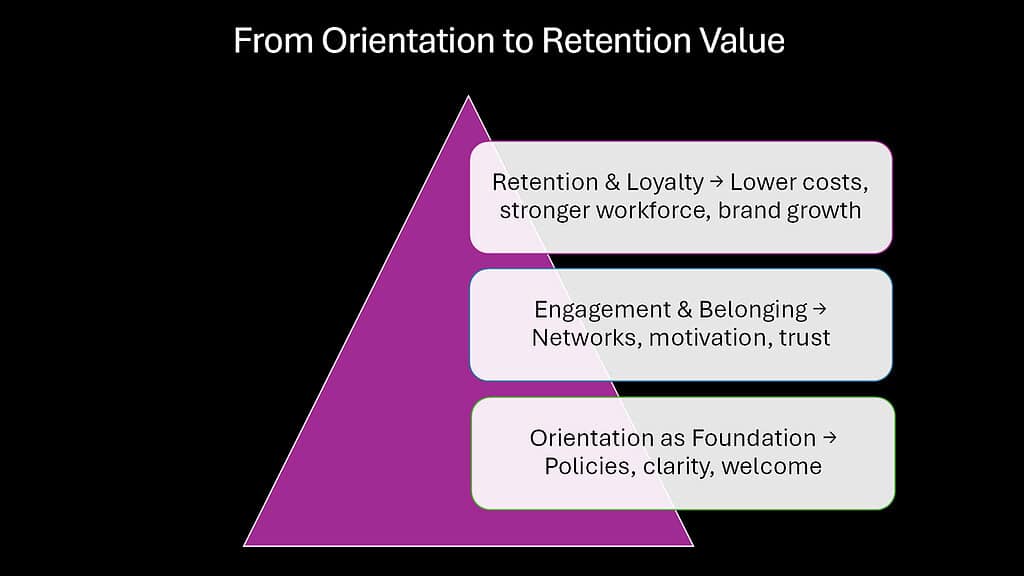
The evidence overwhelmingly demonstrates that strategic orientation programming represents one of the most powerful and underutilized retention tools available to modern organizations. Far from being a mere administrative necessity, well-designed orientation experiences create psychological safety, align expectations, address fundamental human needs, build social connections, apply motivational theory, and signal growth opportunities that transform new hires into committed long-term employees.
The financial implications of effective orientation extend far beyond the immediate program costs. Organizations that invest in comprehensive orientation strategies report significant reductions in early turnover, decreased recruitment expenses, improved employee performance, and enhanced organizational culture. These benefits compound over time as retained employees contribute to productivity, innovation, and knowledge retention while reducing the constant disruption of staff turnover.
The theoretical frameworks explored throughout this analysis provide proven foundations for designing orientation programs that address both rational and emotional factors influencing retention decisions. Amy Edmondson’s psychological safety research, Herzberg’s motivation-hygiene theory, and Maslow’s hierarchy of needs offer complementary approaches that together create comprehensive support systems for new employees during their crucial adjustment period.
Global organizations must recognize that orientation excellence requires ongoing investment and continuous improvement. The most successful companies treat orientation as a strategic capability rather than a one-time event, regularly updating content, measuring outcomes, and adapting approaches based on changing workforce expectations and business requirements. This commitment creates a competitive advantage in talent acquisition and retention that strengthens over time.
The transformation of orientation from administrative formality to strategic retention engine requires leadership commitment, resource allocation, and cultural change throughout the organization. However, the return on this investment manifests through reduced turnover costs, improved employee engagement, enhanced productivity, and a stronger organizational reputation as an employer of choice.
Looking forward, the importance of strategic orientation will only increase as talent competition intensifies and employee expectations continue to evolve. Organizations that recognize orientation as a hidden retention engine and invest accordingly will build sustainable competitive advantages in human capital management while creating positive experiences that benefit both employees and business outcomes for years to come.
Table 8: Strategic Orientation Impact Summary
| Retention Factor | Orientation Influence | Business Outcome |
|---|---|---|
| Psychological Safety | Creates trust and openness from day one | Improved performance and innovation |
| Expectation Alignment | Prevents disappointment and early exits | Reduced turnover and recruitment costs |
| Motivation Enhancement | Addresses hygiene factors and motivators | Increased job satisfaction and engagement |
| Social Integration | Builds relationships and belonging | Stronger team cohesion and collaboration |
| Need Fulfillment | Addresses fundamental human requirements | Higher employee wellbeing and loyalty |
| Growth Signaling | Demonstrates development commitment | Enhanced retention and internal promotion |
| Cultural Fit | Aligns values and behavioral expectations | Improved performance and culture strength |

